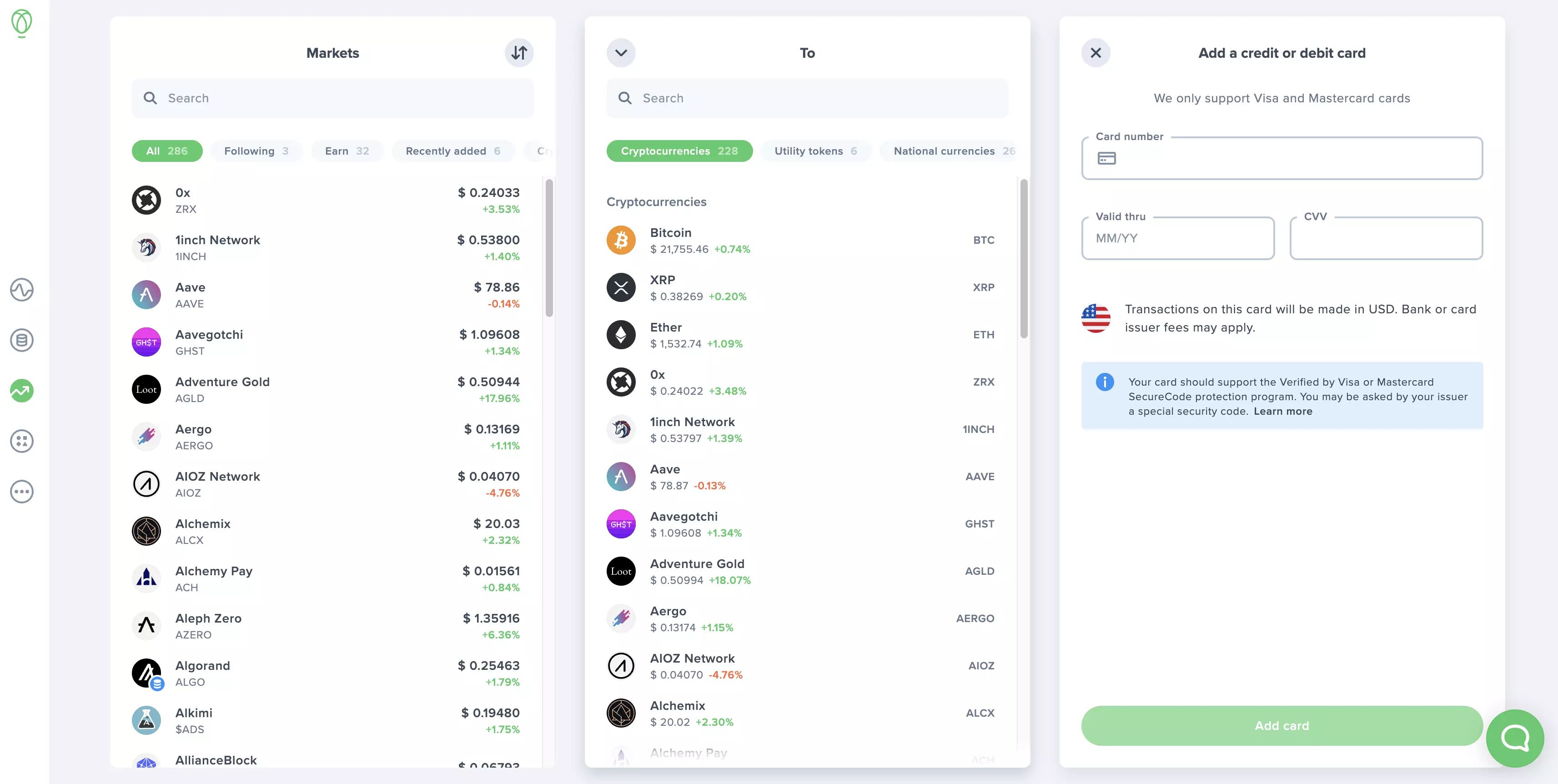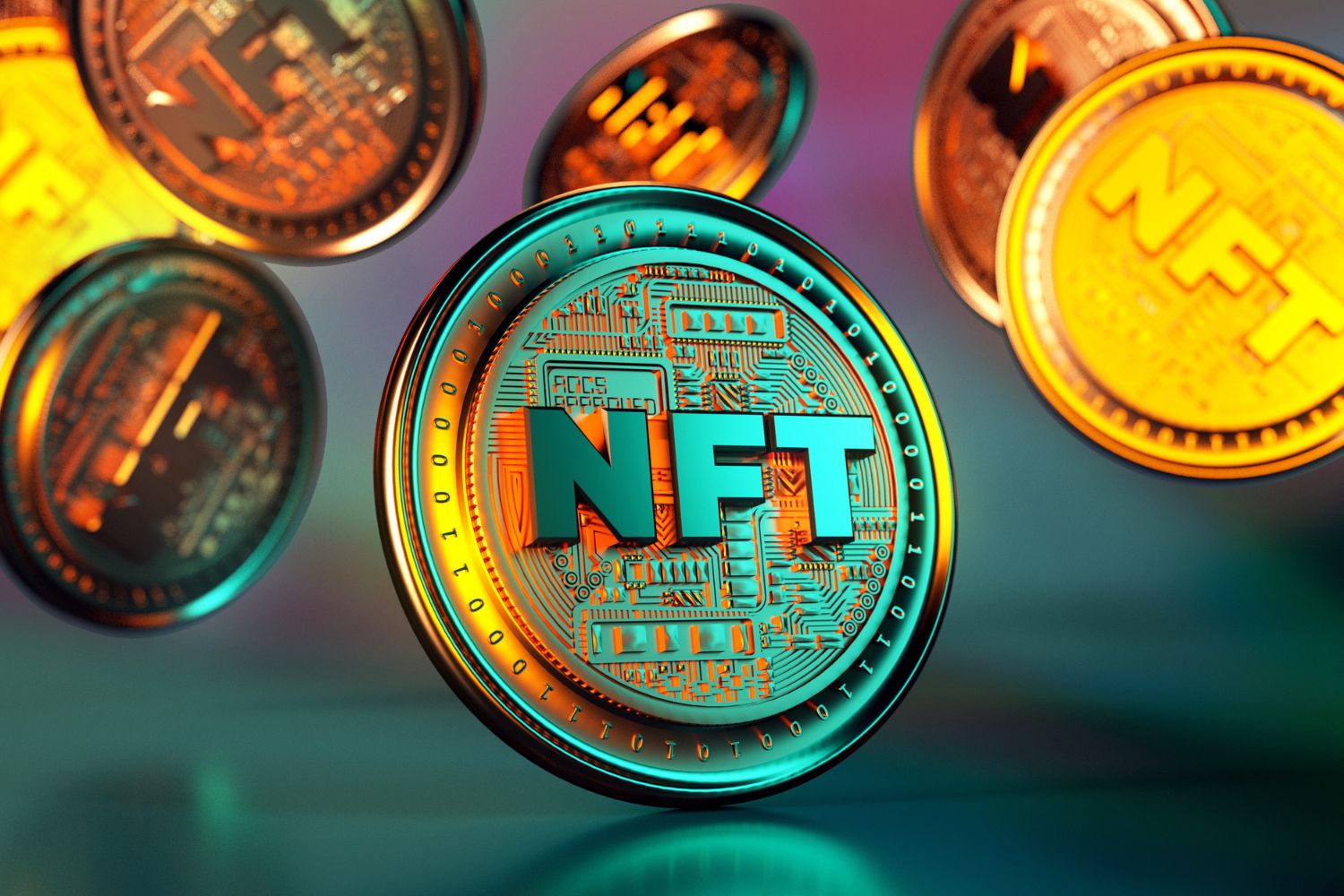Introduction
Welcome to the world of cryptocurrency! Whether you are a seasoned investor or a curious beginner, this comprehensive guide is here to help you navigate the exciting and ever-evolving world of digital currencies. Cryptocurrency has revolutionized the way we transact and store value, offering a decentralized and secure alternative to traditional financial systems.
Since the introduction of Bitcoin in 2009, the cryptocurrency market has experienced explosive growth. With thousands of different cryptocurrencies available today, it can be overwhelming to know where to start. This guide will provide you with the essential information to confidently buy and manage your cryptocurrency portfolio.
Before diving into the intricacies of buying and storing cryptocurrency, it is crucial to understand the basics. Cryptocurrency, often referred to as digital or virtual currency, is a form of money that exists only in electronic form. It utilizes cryptographic technology to secure transactions, control the creation of new units, and verify the transfer of assets.
One of the key attractions of cryptocurrency is its decentralized nature. Unlike traditional currencies issued by central banks, cryptocurrency is not controlled by any government or financial institution. Blockchain technology, the underlying technology powering most cryptocurrencies, ensures transparency, immutability, and security of transactions.
The soaring popularity of cryptocurrencies stems from several factors. Firstly, they provide an alternative investment opportunity that is not tied to traditional financial markets. Cryptocurrencies have generated substantial returns for early adopters, making them an enticing investment option. Secondly, cryptocurrencies enable fast and low-cost international transactions, eliminating the need for intermediaries such as banks or payment processors.
Another significant advantage of cryptocurrencies is their potential to provide financial inclusion for the unbanked population. With over 1.7 billion people globally lacking access to basic financial services, cryptocurrency offers a chance to participate in the global digital economy.
However, it is essential to approach cryptocurrency investments with caution. The market’s volatility and regulatory uncertainties make it a high-risk asset class. Understanding the risks and developing a sound investment strategy is crucial to success in the crypto space.
In the following sections of this guide, we will delve into the different types of cryptocurrencies, choosing the right cryptocurrency exchange, setting up a wallet, security measures to protect your assets, as well as a step-by-step guide on how to buy cryptocurrency. By the end, you will have the knowledge and confidence to start your cryptocurrency journey.
What is Cryptocurrency?
Cryptocurrency is a form of digital or virtual currency that uses cryptography for secure financial transactions, control the creation of new units, and verify the transfer of assets. Unlike traditional currencies issued by central banks, cryptocurrencies are decentralized and operate on a technology called blockchain.
Blockchain technology is a distributed ledger that records all transactions across multiple computers, ensuring transparency and immutability. This means that every transaction is visible to the network participants, and once a transaction is recorded, it cannot be altered.
One of the landmark cryptocurrencies is Bitcoin, introduced in 2009 by an unidentified person or group of people using the pseudonym Satoshi Nakamoto. Bitcoin was the first decentralized cryptocurrency and remains the most well-known and valuable in terms of market capitalization.
Since the advent of Bitcoin, thousands of alternative cryptocurrencies, often referred to as altcoins, have been developed. Each cryptocurrency operates on its own blockchain or a modified version of an existing one. Some notable altcoins include Ethereum, Ripple, Litecoin, and Bitcoin Cash.
The primary purpose of creating cryptocurrencies was to provide a digital form of money that is not controlled by any central authority like governments or financial institutions. This decentralization ensures that transactions are not subject to the manipulation or censorship of a single entity.
Cryptocurrencies offer several advantages over traditional forms of currency. Firstly, they provide secure and fast transactions that can be conducted online without the need for intermediaries like banks. This allows for quick and low-cost global transfers.
Secondly, cryptocurrencies offer financial inclusion to those who are unbanked or underbanked. Approximately 1.7 billion people worldwide lack access to basic financial services. Cryptocurrency provides an opportunity for these individuals to participate in the digital economy, access loans, and engage in international commerce.
Furthermore, cryptocurrencies can act as a hedge against inflation, as most have a limited supply. For example, Bitcoin has a maximum supply of 21 million coins. This scarcity aspect, combined with increasing adoption and demand, has contributed to the value appreciation of many cryptocurrencies.
It’s important to note that the value of cryptocurrencies can be highly volatile. The market is influenced by various factors such as market demand, regulatory changes, technological advancements, and investor sentiment. Therefore, it is essential to research and understand the risks involved before investing in cryptocurrencies.
In the upcoming sections, we will explore the different types of cryptocurrencies, how to choose the right cryptocurrency exchange, set up a secure wallet, and provide a step-by-step guide on buying cryptocurrency. By the end of this guide, you will have a solid foundation for navigating the exciting world of cryptocurrencies.
Why Invest in Cryptocurrency?
Investing in cryptocurrency has become increasingly popular in recent years, attracting the attention of both institutional investors and individual traders. But what are the reasons behind this growing interest? Here are several key factors that make cryptocurrency an attractive investment option.
Potential for High Returns: Cryptocurrencies have the potential for significant price appreciation. Over the past decade, cryptocurrencies like Bitcoin have delivered extraordinary returns, outperforming most traditional investment assets. While past performance is not indicative of future results, the volatility and growth potential of the cryptocurrency market make it an appealing choice for investors seeking high returns.
Diversification: Including cryptocurrencies in your investment portfolio allows for diversification. Cryptocurrencies are not correlated with traditional financial markets such as stocks or bonds, making them an excellent hedge against market downturns. By diversifying across different asset classes, you can spread your risk and potentially enhance your overall returns.
Disruptive Technology: Cryptocurrencies and the underlying blockchain technology have the potential to revolutionize various industries. From finance to supply chain management, healthcare to voting systems, blockchain can enhance efficiency, transparency, and security. By investing in cryptocurrencies, you can support the development and adoption of these disruptive technologies.
Accessible Global Market: Cryptocurrency markets are open 24/7, accessible to anyone with an internet connection. Unlike traditional financial markets, there are no extensive trading hours or barriers to entry. This accessibility allows investors from all around the world to participate and trade cryptocurrencies at their convenience.
Financial Inclusion: Cryptocurrencies have the power to provide financial services to the unbanked and underbanked population worldwide. With over a billion people lacking access to basic financial services, cryptocurrency offers a decentralized and inclusive alternative. By investing in cryptocurrencies, you contribute to the growth of a financial system that can empower individuals and communities.
Growing Adoption: The adoption of cryptocurrencies is steadily increasing. Major companies such as Tesla, PayPal, and Square have embraced cryptocurrencies, accepting them as a form of payment. As more businesses and institutions recognize the value and potential of cryptocurrencies, their mainstream acceptance is likely to continue expanding. Investing in cryptocurrencies allows you to get ahead of the curve and potentially benefit from this growing adoption.
Technological Advancements: The cryptocurrency market is dynamic, constantly evolving, and advancing. New technologies, upgrades, and innovative projects are regularly introduced, driving market growth. By investing in cryptocurrencies, you have the opportunity to support and be part of this exciting technological progression.
It is important to note that investing in cryptocurrencies also carries risks. The market can be highly volatile, with sharp price fluctuations. Regulatory changes, security breaches, and technological challenges can impact the value of cryptocurrencies. It is crucial to conduct thorough research, evaluate your risk tolerance, and make informed investment decisions.
In the following sections, we will explore the different types of cryptocurrencies, how to choose the right cryptocurrency exchange, set up a secure wallet, and provide a step-by-step guide on buying and managing cryptocurrency. By the end of this guide, you will have the knowledge and confidence to navigate the world of cryptocurrency investing.
Understanding the Different Types of Cryptocurrency
The cryptocurrency market is incredibly diverse, with thousands of cryptocurrencies available for investment. Each cryptocurrency operates on its own unique set of rules, features, and purposes. Understanding the different types of cryptocurrencies can help you make informed investment decisions and find projects that align with your goals. Here are some of the main categories of cryptocurrencies:
1. Bitcoin (BTC): Bitcoin is the first and most well-known cryptocurrency, introduced by Satoshi Nakamoto in 2009. It operates on a decentralized peer-to-peer network, allowing for secure and transparent transactions without third-party intermediaries. Bitcoin is often regarded as digital gold and has a limited supply of 21 million coins.
2. Altcoins: Altcoins refer to all cryptocurrencies other than Bitcoin. These alternative coins aim to improve upon Bitcoin’s limitations or offer unique features and applications. Examples of popular altcoins include Ethereum (ETH), Ripple (XRP), Litecoin (LTC), and Cardano (ADA).
3. Stablecoins: Stablecoins are cryptocurrencies designed to minimize price volatility by pegging their value to a stable asset, such as a fiat currency (USD, EUR) or a commodity (gold, oil). Tether (USDT), USD Coin (USDC), and Dai (DAI) are examples of stablecoins commonly used for trading or as a store of value.
4. Utility Tokens: Utility tokens are cryptocurrencies used to access specific products, services, or platforms within a blockchain ecosystem. These tokens serve a purpose beyond value transfer. Examples include Binance Coin (BNB), which is used for reduced trading fees on the Binance exchange, and Filecoin (FIL), which allows users to buy storage space on the Filecoin network.
5. Security Tokens: Security tokens represent ownership in traditional assets, such as real estate, company shares, or bonds. These tokens are subject to securities regulations and provide investors with rights and dividends. Security tokens aim to improve transparency, liquidity, and accessibility in traditional financial markets.
6. Privacy Coins: Privacy coins focus on enhancing anonymity and confidentiality in transactions. They utilize advanced cryptographic techniques to ensure secure and private transactions. Monero (XMR), Zcash (ZEC), and Dash (DASH) are examples of privacy coins that prioritize user privacy.
7. Decentralized Finance (DeFi) Tokens: DeFi tokens are cryptocurrencies that power decentralized financial applications built on blockchain platforms. These applications aim to provide traditional financial services, such as lending, borrowing, and trading, without intermediaries. Popular DeFi tokens include Compound (COMP), Uniswap (UNI), and Aave (AAVE).
It’s important to conduct thorough research and evaluate the fundamentals, team, and potential use cases of each cryptocurrency before investing. Additionally, considering market trends and staying updated with industry news can help identify emerging opportunities in the cryptocurrency space.
Furthermore, diversifying your cryptocurrency portfolio across different types of cryptocurrencies can help manage risk and capture potential value from various sectors within the market.
In the upcoming sections of this guide, we will delve into choosing the right cryptocurrency exchange, setting up a wallet, security measures to protect your assets, and provide a step-by-step guide on buying and managing cryptocurrency. By the end, you’ll have a comprehensive understanding of the cryptocurrency landscape and be well-equipped to navigate this exciting field of investment.
Choosing the Right Cryptocurrency Exchange
When it comes to buying and trading cryptocurrency, choosing the right cryptocurrency exchange is essential. An exchange is an online platform where you can buy, sell, and trade cryptocurrencies. With the growing popularity of cryptocurrencies, there are numerous exchanges available, each offering different features and services. Here are some key factors to consider when selecting a cryptocurrency exchange:
1. Security: Security should be your top priority when choosing an exchange. Look for exchanges that implement strong security measures, such as two-factor authentication (2FA), encryption, and cold storage of funds. Additionally, check if the exchange has a solid reputation and a history of safe operations without major security breaches.
2. User Interface and Experience: A user-friendly and intuitive interface can greatly enhance your trading experience. Look for an exchange with a clean and well-designed interface that provides easy navigation and smooth trading processes. Additionally, consider the availability of mobile applications if you prefer trading on the go.
3. Supported Cryptocurrencies: Different exchanges offer varying selections of cryptocurrencies. Ensure that the exchange you choose supports the specific cryptocurrencies you want to buy or trade. If you are interested in altcoins, make sure the exchange offers a wide range of options beyond just Bitcoin and Ethereum.
4. Liquidity: Liquidity refers to the availability of buyers and sellers on the exchange. A highly liquid exchange allows for easier and quicker execution of trades at the desired prices. Higher liquidity also reduces the risk of price manipulation and ensures smoother trading experiences.
5. Fees and Costs: Pay attention to the fee structure of the exchange. Exchanges charge fees for various actions, such as deposits, withdrawals, and trades. Some exchanges have tiered fee structures based on trading volume, so consider your expected trading activity and choose an exchange with fees that align with your requirements.
6. Customer Support: Reliable customer support can make a significant difference when you encounter issues or have questions about the exchange. Look for exchanges that provide responsive and knowledgeable customer support through various channels, such as live chat, email, or phone.
7. Regulatory Compliance: Ensuring that the exchange operates in compliance with relevant regulations is crucial for safeguarding your investments. Check if the exchange is registered and licensed in a reputable jurisdiction. Compliance with Know Your Customer (KYC) and Anti-Money Laundering (AML) regulations is also an important factor to consider.
8. Reputation and Reviews: Before finalizing your choice, research the reputation and reviews of the exchange. Look for feedback from other users, consider their experiences, and check review platforms or online forums for any red flags or concerns raised by the community.
9. Additional Features: Some exchanges offer additional features such as margin trading, staking, lending, or futures trading. If you have specific requirements or interests in these features, consider choosing an exchange that provides the services you need.
Remember, it is recommended to use multiple exchanges to diversify your holdings and take advantage of different features and opportunities provided by each platform. However, ensure that the exchanges you choose align with your security and usability requirements.
In the upcoming sections of this guide, we will explore setting up a cryptocurrency wallet, security measures to protect your assets, and provide a step-by-step guide on buying and managing cryptocurrency. By the end, you will have the knowledge and confidence to engage in cryptocurrency trading and investment.
Setting up a Wallet
When it comes to owning and storing cryptocurrencies, setting up a secure wallet is crucial. A cryptocurrency wallet is a digital tool that allows you to safely store, send, and receive your digital assets. It is important to have a wallet to ensure the security and control of your cryptocurrency holdings. Here are the main types of wallets and how to set them up:
1. Software Wallets: Software wallets are applications that you can install on your computer or mobile device. They offer convenience and accessibility, allowing you to manage your cryptocurrencies on the go. To set up a software wallet, follow these steps:
- Research reputable software wallet providers and choose one that supports the cryptocurrencies you intend to store.
- Visit the official website or app store to download the software wallet application.
- Follow the installation instructions and create a strong and unique password.
- Once installed, the wallet will generate a unique set of private and public keys for each cryptocurrency you add. Make sure to back up your wallet’s recovery phrase or seed securely.
- Test your wallet by sending a small amount of cryptocurrency to ensure everything is functioning correctly.
2. Hardware Wallets: Hardware wallets are physical devices designed specifically for cryptocurrency storage. They offer the highest level of security by keeping your private keys offline. To set up a hardware wallet, follow these steps:
- Research reputable hardware wallet manufacturers and choose one that suits your needs.
- Purchase the hardware wallet from the official website or authorized resellers.
- Follow the included instructions to set up the hardware wallet. This may involve connecting it to your computer or mobile device.
- During the setup process, the wallet will generate a recovery phrase or seed that you must write down and keep in a secure location.
- Once set up, you can connect the hardware wallet to your computer or mobile device to manage and transact with your cryptocurrencies.
3. Paper Wallets: Paper wallets involve printing out your private and public keys and storing them as a physical copy. While they are not as commonly used due to security concerns, they can be an offline option for long-term storage. To create a paper wallet:
- Use a reputable paper wallet generator website or software.
- Disconnect your computer from the internet to ensure the generation process is offline.
- Follow the instructions on the generator to create a paper wallet.
- Print out the generated private and public keys, ensuring they are not visible on your computer screen.
- Keep the printed paper wallet in a secure location, protecting it from damage and unauthorized access.
Remember, regardless of the type of wallet you choose, it is crucial to follow proper security measures:
- Keep your wallet software and devices updated with the latest security patches.
- Use strong and unique passwords for your wallets.
- Enable two-factor authentication (2FA) whenever possible for an added layer of security.
- Regularly back up your wallets and store the backups in secure offline locations.
By setting up a secure wallet, you maintain control over your cryptocurrency holdings and protect them from unauthorized access and potential losses. In the following sections, we will explore security measures to further safeguard your assets, as well as provide a step-by-step guide on buying and managing cryptocurrency. By the end, you will have the knowledge and confidence to handle your cryptocurrencies with utmost security.
Security Measures: Protecting Your Cryptocurrency
As valuable digital assets, cryptocurrencies require proper security measures to protect them from theft, scams, and unauthorized access. By implementing the following security practices, you can significantly enhance the safety of your cryptocurrency holdings:
1. Strong Wallet Security: Ensure that your cryptocurrency wallet has robust security measures. This includes enabling two-factor authentication (2FA) whenever possible, using strong and unique passwords, and regularly updating your wallet software to the latest version. Additionally, avoid sharing your private keys or recovery phrases with anyone and keep them securely stored offline.
2. Secure Internet Connection: When accessing your cryptocurrency wallet or trading on exchanges, always use a secure internet connection. Avoid using public Wi-Fi networks, as they may expose your sensitive information to potential attackers. Instead, use a trusted and private internet connection to safeguard your transactions and account information.
3. Be Wary of Phishing Attempts: Phishing is a common tactic used by cybercriminals to trick users into revealing their login credentials or private keys. Be cautious of suspicious emails, messages, or websites that prompt you to disclose your sensitive information. Always double-check the website’s URL and ensure you are on the legitimate platform before entering any personal details or passwords.
4. Keep Software Up-to-Date: Regularly update your computer or mobile device’s operating system, antivirus software, and cryptocurrency wallet applications. Software updates often include important security patches and fixes that protect against potential vulnerabilities. Staying up-to-date with the latest software versions reduces the risk of unauthorized access or malicious attacks.
5. Utilize Hardware Wallets: Consider using a hardware wallet for storing your cryptocurrencies. Hardware wallets keep your private keys offline, reducing the risk of online attacks. These physical devices provide an extra layer of security and are resistant to computer viruses or malware that may compromise software wallets.
6. Diversify and Backup: Diversify your cryptocurrency holdings across multiple wallets and exchanges. By spreading your assets, you minimize the risk of losing everything in the event of a security breach. Additionally, regularly back up your wallets and recovery phrases in separate, secure offline locations. This ensures that even if one backup is compromised, you still have access to your cryptocurrencies through another backup.
7. Research Exchanges and Third-Party Services: Before using an exchange or any third-party service related to cryptocurrencies, conduct thorough research. Ensure that the platform has a solid reputation, strong security measures, and favorable user reviews. Beware of suspicious platforms or services that promise unrealistic returns or ask for excessive personal information.
8. Stay Updated with Security News: Stay informed about the latest security threats, scams, and best practices in the cryptocurrency community. Follow reputable cryptocurrency news sources and forums to stay updated on potential risks and learn from the experiences of others. By staying informed, you can better protect yourself and your investments.
Remember that no security measure is foolproof, but by implementing these practices, you can significantly reduce the risk of unauthorized access or loss of your cryptocurrencies. Prioritize security and remain vigilant to protect your valuable digital assets.
In the following sections, we will provide a step-by-step guide on buying and managing cryptocurrency. By combining security measures with proper investment strategies, you can confidently navigate the cryptocurrency market and protect your investments.
Buying Cryptocurrency: Step-by-Step Guide
Ready to jump into the world of cryptocurrency and make your first purchase? Follow this step-by-step guide to buy cryptocurrency:
Step 1: Choose a Cryptocurrency Exchange: Research and choose a reputable cryptocurrency exchange that suits your needs. Consider factors such as security, supported cryptocurrencies, fees, and user experience. Some popular exchanges include Coinbase, Binance, and Kraken.
Step 2: Create an Account: Sign up for an account on the chosen cryptocurrency exchange. Provide the required personal information and complete any verification process if necessary. This may include submitting identification documents to comply with Know Your Customer (KYC) regulations.
Step 3: Set Up Two-Factor Authentication (2FA): Enable two-factor authentication (2FA) for an extra layer of security. This typically involves linking your account with an authentication app, such as Google Authenticator or Authy. 2FA adds an additional verification step when you log in or perform certain actions on the exchange.
Step 4: Deposit Funds: Deposit funds into your exchange account. Most exchanges support various deposit methods, including bank transfers, credit/debit cards, and sometimes even PayPal. Follow the instructions provided by the exchange to deposit your desired amount of funds.
Step 5: Choose the Cryptocurrency to Buy: Once your account is funded, select the cryptocurrency you want to buy. Popular options include Bitcoin (BTC), Ethereum (ETH), and Litecoin (LTC). Alternatively, you can explore other cryptocurrencies available on the exchange and choose based on your research and investment strategy.
Step 6: Place an Order: Specify the type of order you want to place. There are typically two types: market orders and limit orders. A market order executes immediately at the current market price, while a limit order allows you to set a specific price at which you want to buy the cryptocurrency.
Step 7: Review and Confirm: Double-check the details of your order before confirming the purchase. Pay close attention to the amount and price of the cryptocurrency you are buying to ensure accuracy.
Step 8: Store Your Cryptocurrency: Once the purchase is complete, transfer your newly acquired cryptocurrency from the exchange to a secure wallet. If you already have a software or hardware wallet set up, provide the wallet address to the exchange and initiate the withdrawal. If you don’t have a wallet, consider setting one up following the instructions provided in the “Setting up a Wallet” section of this guide.
Step 9: Take Security Precautions: After transferring your cryptocurrency to your wallet, ensure that you secure your wallet with strong passwords, enable any available security features, and back up your private keys or recovery phrases. This adds an extra layer of protection to your holdings.
Step 10: Monitor and Manage Your Investment: Stay informed about the cryptocurrency market and track the performance of your investment. Consider setting price alerts or utilizing portfolio management tools to keep track of your holdings. Regularly review and adjust your investment strategy based on market conditions and your goals.
Remember, the cryptocurrency market can be highly volatile, and it’s important to approach investing with caution and conduct thorough research. Only invest what you can afford to lose and consider seeking advice from financial professionals if needed.
By following this step-by-step guide and practicing proper security measures, you can confidently buy and manage your cryptocurrency investments.
Storing and Managing Your Cryptocurrency
Once you have purchased cryptocurrency, it’s important to have a secure system in place for storing and managing your digital assets. Here are some essential tips for effectively storing and managing your cryptocurrency:
1. Use Secure Wallets: A cryptocurrency wallet is a digital tool that allows you to securely store, send, and receive your digital assets. Choose a reputable wallet that aligns with your needs, whether it be a software, hardware, or paper wallet. Make sure to follow best practices for wallet security, such as enabling two-factor authentication (2FA), using strong passwords, and keeping your private keys or recovery phrases offline.
2. Diversify Your Storage: Consider diversifying your cryptocurrency storage across multiple wallets and platforms. This creates an additional layer of protection and reduces the risk of losing all your assets if one wallet is compromised. However, always prioritize security and ensure that each wallet you use is trustworthy and properly secured.
3. Regularly Update Wallet Software: Keep your wallet software up to date with the latest versions and security patches. Software updates often include bug fixes and security enhancements, ensuring that your wallet remains secure against potential vulnerabilities.
4. Be Cautious of Online Threats: Stay vigilant and be cautious of various online threats that could compromise the security of your cryptocurrency. Be wary of phishing attempts, fake websites, and suspicious links. Always double-check URLs, emails, and messages to verify their authenticity before entering any sensitive information.
5. Backup Your Wallets: Regularly backup your wallets and keep the backup files securely stored offline. This ensures that you have a copy of your wallet’s private keys or recovery phrases in case of loss, theft, or hardware failure. Store backups in multiple secure locations, such as encrypted external hard drives or offline storage devices.
6. Practice Cold Storage: Consider utilizing cold storage methods for long-term asset storage. Cold storage involves keeping your private keys offline, away from any internet-connected devices. Hardware wallets and paper wallets are popular options for cold storage, providing an extra layer of protection against hacking and cyber threats.
7. Stay Informed About Security Risks: Stay updated on the latest security practices and potential risks in the cryptocurrency space. Follow reputable cryptocurrency news sources, participate in online communities, and monitor security-related announcements from wallet providers and exchanges. This will help you stay proactive in safeguarding your assets.
8. Manage Risk and Monitor Market Conditions: Regularly assess and manage your cryptocurrency portfolio based on market conditions and your investment goals. Set realistic expectations and diversify your holdings to manage risk effectively. Consider utilizing portfolio management tools or cryptocurrency tracking apps to monitor the performance of your investments.
9. Keep Your Private Information Private: Avoid sharing personal and sensitive information related to your cryptocurrency holdings. Be cautious of sharing wallet addresses publicly or engaging in discussions that reveal your investment strategies or financial details. Keeping this information private helps minimize the risk of targeted attacks or scams.
By following these storage and management practices, you can enhance the security and overall management of your cryptocurrency investments. Remember that security should always be a top priority, and staying informed and proactive will help protect your digital assets.
In the following sections, we will provide additional tips for successful crypto investment and address frequently asked questions to further enhance your understanding of the cryptocurrency world.
Tips for Successful Crypto Investment
Investing in cryptocurrencies can be both exciting and rewarding, but it’s essential to approach it with caution and a well-thought-out strategy. Here are some valuable tips to help you navigate the world of crypto investment:
1. Do Your Research: Thoroughly research and understand the cryptocurrencies you are interested in before investing. Look into the project’s fundamentals, team, technology, adoption potential, and market trends. Investing based on informed decisions is more likely to yield positive results.
2. Diversify Your Portfolio: Diversification is key in any investment strategy. Spread your investment across multiple cryptocurrencies and sectors within the crypto market. This helps reduce risk and allows you to capitalize on potential opportunities in different areas of the industry.
3. Set Clear Goals: Define your investment goals and risk tolerance upfront. Are you looking for short-term gains or long-term growth? Having clarity on your objectives can help you make informed decisions and avoid impulsive actions based on short-term market fluctuations.
4. Keep Emotions in Check: Cryptocurrency markets can be highly volatile, with extreme price fluctuations. Avoid making investment decisions based solely on emotions or market hype. Instead, rely on research, analysis, and a long-term perspective to guide your actions.
5. Stay Informed: Keep up-to-date with industry news, regulatory developments, and market trends. Understanding the broader context of the cryptocurrency market can help you make better investment decisions. Follow reputable sources and engage with the community to expand your knowledge and stay informed.
6. Start Small: Begin with small investments and gradually increase your exposure as you gain more experience and confidence. Learning from the market dynamics and adjusting your strategy along the way allows you to minimize potential losses as you become more comfortable with the risks involved.
7. Implement Risk Management: Develop and stick to a risk management strategy. Set clear stop-loss limits and profit targets to protect your capital and lock in gains. Consider utilizing risk management tools and techniques such as trailing stop-loss orders to manage your positions effectively.
8. Be Patient: Cryptocurrency markets can be highly volatile, and it’s crucial to exercise patience. Avoid making impulsive trades based on short-term price movements. Invest for the long term and focus on the underlying fundamentals of the projects you believe in.
9. Seek Professional Advice: If you are uncertain or lack experience in cryptocurrency investment, consider seeking guidance from professionals. Consult financial advisors or experts in the field to help you make sound investment decisions aligned with your financial goals and risk tolerance.
10. Practice Good Security Measures: Protect your investments by implementing strict security measures. Use secure wallets, enable two-factor authentication (2FA), regularly update your software, and avoid sharing sensitive information. Staying vigilant against scams and phishing attempts is crucial to safeguard your funds.
Remember, investing in cryptocurrencies carries inherent risk, and there are no guarantees of returns. It’s important to invest only what you can afford to lose and continuously educate yourself in the ever-evolving crypto landscape.
Keep these tips in mind as you navigate the world of crypto investment, and always make informed decisions based on thorough research and analysis. In the following sections, we will address frequently asked questions and provide additional insights to further enhance your understanding of cryptocurrencies.
Frequently Asked Questions (FAQs)
Q: What is the best cryptocurrency to invest in?
A: The best cryptocurrency to invest in depends on various factors, including your risk tolerance, investment goals, and market conditions. It’s important to conduct thorough research and consider factors such as the project’s fundamentals, team, technology, and potential for adoption. Diversification is also key in managing risk.
Q: How much should I invest in cryptocurrency?
A: The amount you should invest in cryptocurrency depends on your personal financial situation and risk tolerance. Only invest what you can afford to lose, as the cryptocurrency market can be highly volatile. It’s recommended to start with a small percentage of your overall investment portfolio and gradually increase your exposure as you gain experience and confidence.
Q: How do I secure my cryptocurrency?
A: To secure your cryptocurrency, use secure wallets such as hardware wallets or software wallets with strong passwords and two-factor authentication (2FA). Keep your private keys or recovery phrases secure and offline, and regularly update your wallet software. Be cautious of phishing attempts and ensure you only use reputable exchanges and third-party services.
Q: How do I buy cryptocurrency with fiat currency?
A: To buy cryptocurrency with fiat currency, you can use a cryptocurrency exchange that supports fiat deposits. Set up an account on the chosen exchange, complete any necessary verification, and deposit your fiat currency through bank transfers or other accepted payment methods. Once your account is funded, you can choose the cryptocurrency you want to buy and complete the purchase.
Q: Can I lose all my money by investing in cryptocurrency?
A: Yes, investing in cryptocurrency carries inherent risks, including the potential loss of your investment. The cryptocurrency market is highly volatile, and prices can experience significant fluctuations. It’s important to evaluate your risk tolerance, conduct thorough research, and make informed investment decisions. Diversification, proper risk management, and staying informed are key aspects to mitigate potential losses.
Q: How do I sell my cryptocurrency?
A: To sell your cryptocurrency, you can use a cryptocurrency exchange. Log in to your exchange account, navigate to the sell section, specify the amount and type of cryptocurrency you want to sell, and set your desired price or choose a market order. Once the sell order is executed, the funds will be credited to your account, and you can withdraw them to your bank account or another desired method.
Q: Is cryptocurrency legal?
A: The legality of cryptocurrency varies from country to country. While some countries fully recognize and regulate cryptocurrencies, others have imposed restrictions or outright bans. It’s important to research and comply with the laws and regulations of your jurisdiction when it comes to cryptocurrency ownership, trading, and taxation.
Q: How do I keep track of my cryptocurrency investments?
A: You can keep track of your cryptocurrency investments using portfolio management tools or cryptocurrency tracking apps. These platforms allow you to monitor the performance of your holdings, track prices, set alerts for price movements, and review your overall portfolio balance. They can provide valuable insights and help you make informed decisions regarding your investments.
Q: What are the risks of investing in cryptocurrency?
A: Investing in cryptocurrency carries several risks, including market volatility, regulatory uncertainties, security breaches, and technological challenges. The cryptocurrency market is still relatively young and can be influenced by factors such as market sentiment and investor speculation. It’s crucial to conduct thorough research, diversify your investments, and be prepared for the potential loss of your investment.
Q: Can I use cryptocurrency for everyday transactions?
A: Cryptocurrency adoption for everyday transactions is increasing, with some businesses accepting cryptocurrencies as a payment method. However, widespread acceptance is still limited. Cryptocurrency’s primary use case currently remains as a speculative investment or a store of value. It’s important to research and understand the specific use cases and acceptance of cryptocurrencies in your region.
Remember, the cryptocurrency market is dynamic and evolving, and it’s crucial to stay updated and informed about the latest developments and trends in the industry. Consulting financial professionals and conducting your due diligence can greatly enhance your understanding and decision-making in the world of cryptocurrencies.
Conclusion
Congratulations! You have reached the end of this comprehensive guide on buying, storing, and managing cryptocurrency. Throughout this guide, we have covered the fundamental aspects of cryptocurrencies, the importance of choosing the right exchange, setting up secure wallets, implementing security measures, and tips for successful crypto investment.
By now, you should have a solid understanding of the different types of cryptocurrencies, the steps involved in purchasing cryptocurrency, and the best practices for storing and managing your digital assets securely. Remember, security should always be a top priority when dealing with cryptocurrencies, as the decentralized nature of this digital currency makes it a target for attackers.
Investing in cryptocurrencies can be highly rewarding, but it comes with its own set of risks. It’s crucial to conduct thorough research, diversify your investments, and approach the market with a long-term perspective. Stay informed about market trends, regulatory changes, and the latest security practices to navigate the ever-evolving world of cryptocurrencies.
As with any investment, only invest what you can afford to lose, and seek professional advice if you are uncertain about any aspect of cryptocurrency investing. The crypto market can be volatile, and prices can fluctuate significantly. Maintaining a disciplined and cautious approach is key to navigate the ups and downs of this dynamic market.
We hope this guide has provided valuable insights and guidance to help you embark on your cryptocurrency journey. Remember to stay informed, continue learning, and adapt to the evolving crypto landscape. As the technology and adoption of cryptocurrencies progress, new opportunities and challenges will emerge.
Always prioritize security, conduct your due diligence, and make informed decisions. Good luck in your cryptocurrency endeavors!

























